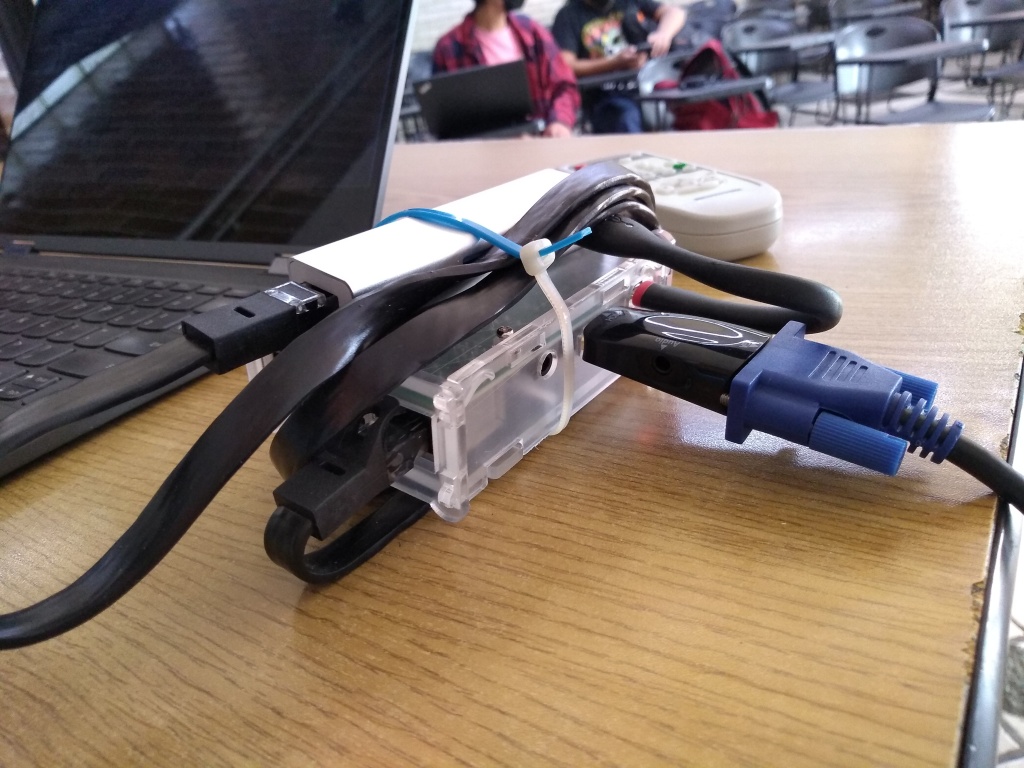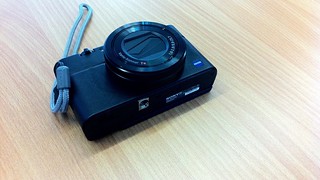
Almost ten months ago, I
mentioned on this
blog
I bought an ARM laptop, which is now my main machine while away from
home a
Lenovo Yoga C630
13Q50. Yes,
yes, I am still not as much
away from home as I used to before, as
this pandemic is still somewhat of a thing, but I do move more.
My main activity in the outside world with my laptop is teaching. I
teach twice a week, and well, having a display for my slides and
for showing examples in the terminal and such is a must. However, as I
said back in August, one of the hardware support issues for this
machine is:
No HDMI support via the USB-C displayport. While I don t expect
to go to conferences or even classes in the next several months,
I hope this can be fixed before I do. It s a potential important
issue for me.
It has sadly not yet been solved While many things have improved
since kernel 5.12 (the first I used), the Device Tree does not yet
hint at where external video might sit.
So, I went to the obvious: Many people carry different kinds of video
adaptors I carry a
slightly bulky one: A RPi3

For two months already (time flies!), I had an ugly contraption where
the RPi3 connected via Ethernet and displayed a VNC client, and my
laptop had a VNC server. Oh, but did I mention My laptop works
so
much better with Wayland than with Xorg that I switched, and am now a
happy user of the
Sway compositor (a drop-in
replacement for the
i3 window manager). It is
built over
WLRoots,
which is a great and (relatively) simple project, but will thankfully
not carry some of Gnome or KDE s ideas not even those I d rather
have. So it took a bit of searching; I was very happy to find
WayVNC, a VNC server for
wlroot-sbased Wayland compositors. I launched a
second Wayland, to
be able to have my main session undisturbed and present only a window
from it.
Only that VNC is slow and laggy, and sometimes awkward. So I kept
searching for something better. And something better is, happily, what
I was finally able to do!
In the laptop, I am using
wf-recorder to grab an area
of the screen and funnel it into a
V4L2 loopback
device (which allows it to
be used as a camera, solving the main issue with grabbing parts of a
Wayland screen):
/usr/bin/wf-recorder -g '0,32 960x540' -t --muxer=v4l2 --codec=rawvideo --pixelformat=yuv420p --file=/dev/video10
(yes, my V4L2Loopback device is set to
/dev/video10). You will note
I m grabbing a 960 540 rectangle, which is the top of my screen
(1920x1080) minus the Waybar. I think I ll increase it to 960 720, as
the projector to which I connect the Raspberry has a 4 3 output.
After this is sent to
/dev/video10, I tell
ffmpeg to send it via
RTP to
the fixed address of the Raspberry:
/usr/bin/ffmpeg -i /dev/video10 -an -f rtp -sdp_file /tmp/video.sdp rtp://10.0.0.100:7000/
Yes, some uglier things happen here. You will note
/tmp/video.sdp
is created in the laptop itself; this file
describes the stream s
metadata so it can be used from the client side. I cheated and copied
it over to the Raspberry, doing an ugly hardcode along the way:
user@raspi:~ $ cat video.sdp
v=0
o=- 0 0 IN IP4 127.0.0.1
s=No Name
c=IN IP4 10.0.0.100
t=0 0
a=tool:libavformat 58.76.100
m=video 7000 RTP/AVP 96
b=AS:200
a=rtpmap:96 MP4V-ES/90000
a=fmtp:96 profile-level-id=1
People familiar with RTP will scold me: How come I m streaming to the
unicast client address? I should do it to an address in the
224.0.0.0 239.0.0.0 range. And it worked, sometimes. I switched over
to 10.0.0.100 because it works, basically always
Finally, upon bootup, I have configured
NoDM to start a session with
the
user user, and dropped the following in my user s
.xsession:
setterm -blank 0 -powersave off -powerdown 0
xset s off
xset -dpms
xset s noblank
mplayer -msglevel all=1 -fs /home/usuario/video.sdp
Anyway, as a result, my students are able to much better follow the
pace of my presentation, and I m able to do some tricks better
(particularly when it requires quick reaction times, as often happens
when dealing with concurrency and such issues).
Oh, and of course in case it s of interest to anybody, knowing that
SD cards are all but reliable in the long run, I wrote a
vmdb2 recipe to build the images.
You can
grab it
here; it
requires some local files to be present to be built some are the
ones I copied over above, and the other ones are surely of no interest
to you (such as my public ssh key or such :-] )
What am I still missing? (read: Can you help me with some ideas? )
- I d prefer having Ethernet-over-USB. I have the USB-C Ethernet
adapter, which powers the RPi and provides a physical link, but I m
sure I could do away with the fugly cable wrapped around the
machine
- Of course, if that happens, I would switch to a much sexier Zero
RPi. I have to check whether the video codec is light enough for a
plain ol Zero (armel) or I have to use the much more powerful Zero
2 I prefer sticking to the lowest possible hardware!
-
Naturally The best would be to just be able to connect my
USB-C-to- HDMI,VGA adapter, that has been sitting idly One
day, I guess

Of course, this is a blog post published to brag about my stuff, but
also to serve me as persistent memory in case I need to recreate
this
 As announced some time ago on Debian Backport s mailing list I will be backporting Qt 6 to Debian 11 Bullseye . This comprises the (so far) 29 source packages that compose Qt 6 and libassimp.
The Qt Company wanted to let us Debian users also enjoy Qt 6 on Bullseye, so they contacted me (and by extension my employer ICS) to bring this forward. As said in the mail I sent to the backports list I m making the commitment to maintain the packages myself, but I m really happy the Qt Company asked me for this.
You can download Qt 6 for Debian Bullseye s backports by following the instructions.
Also a big kudos to IOhannes m zm lnig, the assimp maintainer, who promptly helped me to get it backported.
Enjoy!
As announced some time ago on Debian Backport s mailing list I will be backporting Qt 6 to Debian 11 Bullseye . This comprises the (so far) 29 source packages that compose Qt 6 and libassimp.
The Qt Company wanted to let us Debian users also enjoy Qt 6 on Bullseye, so they contacted me (and by extension my employer ICS) to bring this forward. As said in the mail I sent to the backports list I m making the commitment to maintain the packages myself, but I m really happy the Qt Company asked me for this.
You can download Qt 6 for Debian Bullseye s backports by following the instructions.
Also a big kudos to IOhannes m zm lnig, the assimp maintainer, who promptly helped me to get it backported.
Enjoy!
 Almost ten months ago, I
Almost ten months ago, I 


 Sony RX100-III, relegated to a webcam
Sony RX100-III, relegated to a webcam


